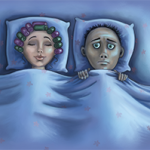CHICAGO—“The line between ACR and ARHP sessions has totally blurred,” said Donah Zack Crawford, MA, during the presentation, Highlights from the 2011 ARHP Sessions, at the 2011 ACR/ARHP Annual Scientific Meeting held in Chicago in November 2011. Joining Crawford, who is research coordinator with The Arthritis Group in Philadelphia, for what she said was the first ARHP meeting roundup, was Robert R. McLean, DSc, MPH, an epidemiologist at Hebrew SeniorLife’s Institute for Aging Research and assistant professor of medicine at Harvard Medical School, both located in Boston. The presentations they reviewed on the last day of the meeting did have a selection bias, as “these topics are near and dear to our hearts,” said Crawford. [Editor’s note: This session was recorded and is available via ACR SessionSelect at www.rheumatology.org.]
Sleep Success
In introducing her review of ARHP keynote speaker James B. Maas, PhD, a sleep researcher from Cornell University in Ithaca, N.Y., Crawford said that Dr. Maas coined the term power nap. Dr. Maas presented the keynote address, “Sleep for Success! Everything You Must Know About Sleep But Were Too Tired to Ask.”
Adults who never sleep seven to eight hours a night never get the kinds of brain waves they need, according to research from Dr. Maas’ sleep laboratory. As a result, these people are more likely to be unhealthy and live shorter lives. Lack of sleep increases the risk of hypertension, depression, diabetes, periodontal disease, obesity, and cancer. Teenagers need more sleep than adults—9.25 hours nightly—yet they receive just six hours on average.
Aside from the need to get enough sleep, Dr. Maas recommended good sleep hygiene, such as consuming no caffeine after 2 p.m. and sleeping in complete darkness, said Crawford.
Medical Marijuana
Differing viewpoints made up a session called, “Debate: Joints for Joints: Medical Marijuana Is Useful for Treating Rheumatic Disease.” Debating against medical marijuana was Stuart L. Silverman, MD, of Cedars-Sinai Medical Center in Beverly Hills, Calif. The opposing view came from Arthur F. Kavanaugh, MD, of the University of California, San Diego.
Dr. Silverman’s concerns about medical marijuana include poor product labeling, potential for product contamination, and conflicts between federal and state laws, Crawford said. There also is confusion about dose and delivery systems. “Apparently, the ability of marijuana in a brownie to be equally distributed is somewhat limited,” she recounted from the presentation. Drs. Silverman and Kavanaugh suggested that edible products or vaporizers make better drug delivery systems than smoking.



